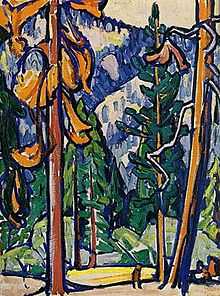Marguerite Zorach
| Marguerite Zorach | |
|---|---|
 Marguerite Zorach in her studio | |
| Born | September 25, 1887 |
| Died | June 27, 1968 (aged 80) |
| Nationality | American |
| Known for | painting |
| Awards | Logan Medal |
Marguerite Zorach (née Thompson) (September 25, 1887 – June 27, 1968) was an American fauvist painter, textile artist, and graphic designer and was an early exponent of modernism in America. She won the 1920 Logan Medal of the Arts.[1]
Life

Marguerite was born in Santa Rosa, California. Her father, a lawyer for the Napa vineyards, and mother were descended from New England seafarers and Pennsylvania Quakers. She began drawing at a very young age and her parents gave her a very liberal education, music lessons in elementary school, and four years of Latin at Fresno High School. She was one of a small group of women admitted to Stanford University in 1908.[2] Rather than completing university in the United States, however, she traveled to France at the invitation of her aunt, Harriet Adelaide Harris.[3] There she attended the post-impressionist school Académie de La Palette, where she met William Zorach, and associated with Pablo Picasso and ex-patriate Gertrude Stein. She exhibited at the 1910 Société des Artistes Indépendants, and the 1911 Salon d'Automne.
She married William Zorach, on December 24, 1912, in New York City.[4] In 1937 William was commissioned by the Works Progress Administration to create a marble sculpture, Benjamin Franklin, the First Colonial Postmaster, for the Post Office's new building in Washington, D.C (now called the Clinton Federal Building).[5] They had a son, Tessim Zorach, and a daughter, artist Dahlov Ipcar. They lived in New York, and spent summers in New England. In 1922, they visited Gaston Lachaise at Georgetown, Maine, and later bought a house. They were friends with Marsden Hartley, F. Holland Day, Gertrude Kasebier, and Paul Strand.[6]
Career


Her work appeared in the 1913 Armory Show.[7] Marguerite continued to paint and began to work with textiles, using embroidery and batik.[8]
She was an innovator of the American modernist movement and helped introduce fauvist and cubist styles to the United States. After traveling extensively in Egypt, Palestine, India, and Japan, she returned home to produce brightly colored Fauvist landscapes with thick black outlines. Her style developed and included more Cubist structure until she turned to creating embroidered tapestries after the birth of her two children. While she continued to paint and assist her husband, William Zorach, on larger projects, her main focus was on these tapestries. While her artistic expression was mainly through textiles, her 1938 oil-on-canvas mural in the lobby at the Peterborough, New Hampshire post office, entitled New England Post in Winter, showed her modernist talent. In 1940, she completed the mural Autumn for the WPA in Ripley, Tennessee.
Holdings
The Monticello, Indiana post office contains her 1942 Section of Fine Arts mural entitled Hay Making. The Smithsonian American Art Museum has, in storage, a 1939 watercolor and pencil on paper mounted on paperboard mural study that was rejected[9] for the Fresno, California Post Office and Courthouse.
Honors and retrospectives
In 1964, Zorach received a D.F.A. from Bates College. In 2007, the Gerald Peters Gallery held a retrospective exhibition of her work.[10] In 2010, her watercolors were exhibited at the Michael Rosenfeld Gallery.[11] In 2011, a retrospective is being held at Franklin & Marshall College.[12]
References
- ↑ "Marguerite Thompson Zorach". IFPDA. Retrieved 2014-08-12.
- ↑ Rubenstein, Charlotte Streifer, ‘’American Women Artists: from Early Indian Times to the Present’’, Avon Publishers 1982 p, 7.
- ↑ "To Be Modern: The Origins of Marguerite and William Zorach's Creative Partnership, 1911-1922; essay by Jessica Nicoll". Tfaoi.com. Retrieved 2014-08-12.
- ↑
- ↑ "Environment Protection Agency Bldg. Reliefs and Sculptures". livingnewdeal.org. Living New deal. Retrieved 19 December 2014.
- ↑ Deborah Weisgall. "Marguerite Zorach: Georgetown Goes Modern: The Modern Art Movement Meets an Island Community". The Maine Magazine.
- ↑ Landscape, Marguerite Zorach
- ↑ "The Textile Art of Marguerite Zorach", Hazel Clark, Woman's Art Journal, Vol. 16, No. 1 (Spring - Summer, 1995), pp. 18-25.
- ↑ "Margueritte Zorach - BIO". artprice.com. Art Price. Retrieved 26 December 2014.
- ↑ Roberta Smith (June 1, 2007). "Art in Review; Marguerite Zorach -- A Life in Art". The New York Times.
- ↑
- ↑ August 12, 2014 (2011-10-09). "F&M to host Zorach exhibit - Entertainment". LancasterOnline.com. Retrieved 2014-08-12.
External links
| Wikimedia Commons has media related to Marguerite Thompson Zorach. |
- Official website
- "Marguerite Zorach", Smithsonian Museum of American Art
- "Marguerite Zorach", Gerald Peters Gallery
|